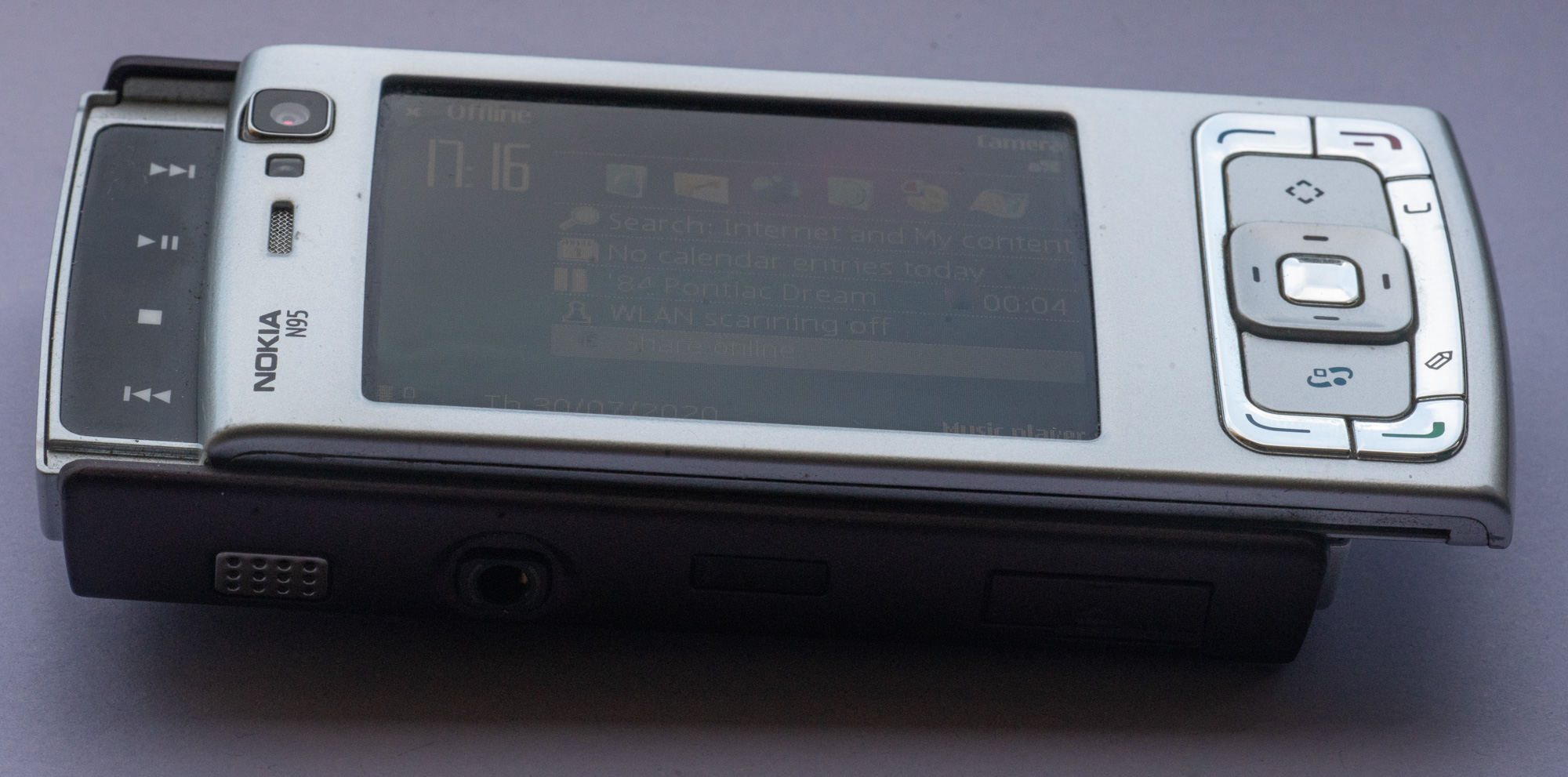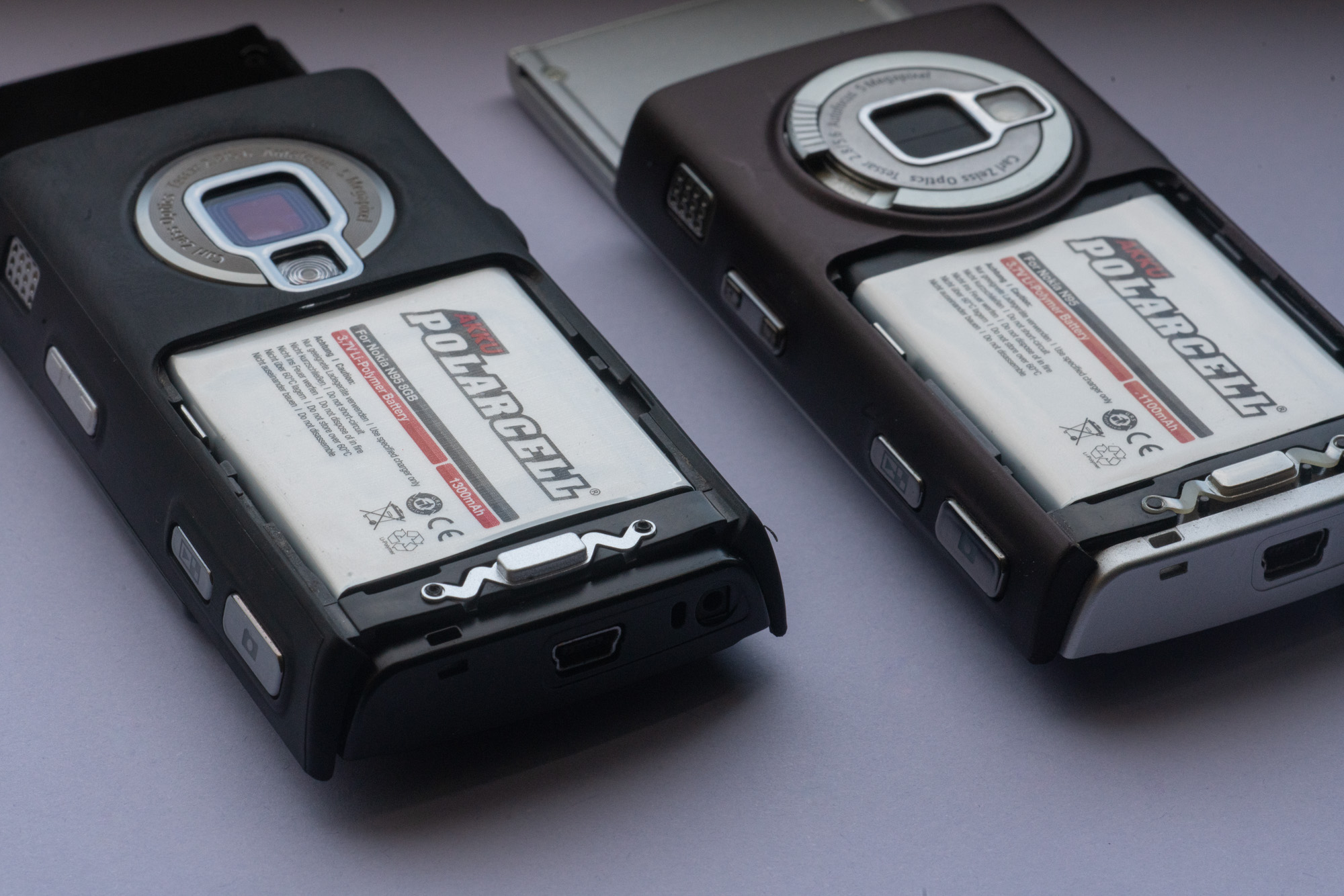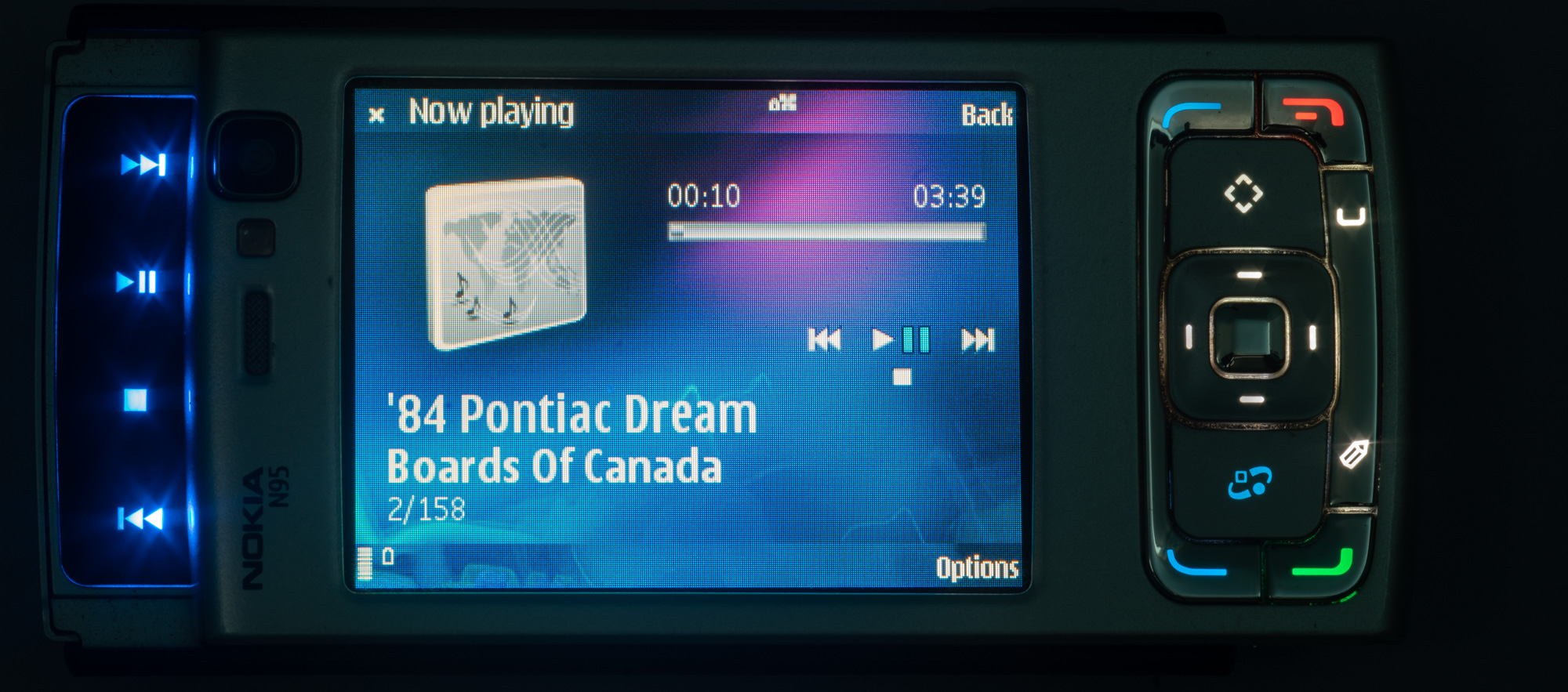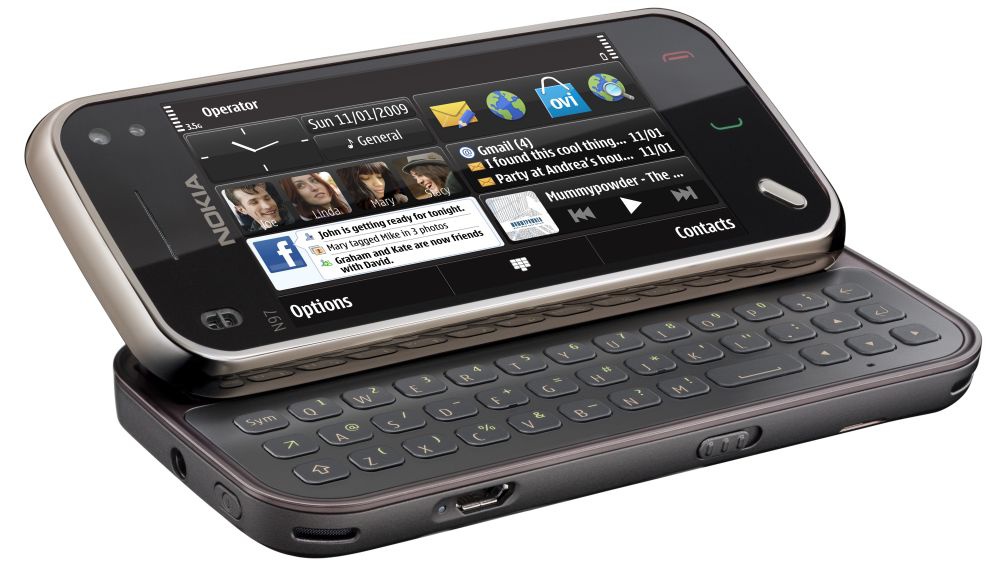
Nokia N95 was announced at the end of 2006 and went on sale in 2007 after the first Apple iPhone was announced. Compared to later models, on which you can rather study the problems of the Finnish mobile phone manufacturer, the N95 was a completely reasonable choice for a person with money. Non-standard "double slider", high-quality 5-megapixel camera, the ability to connect headphones without adapters, a slot for memory cards. Compared to competing smartphones, Windows Mobile only lacked a large screen, but the consumer's habit of shovels still had to be formed.
Nokia N95 was not even called a mobile phone in advertising materials. They used the motto: "This is how the computer looks now." Well, let's take a look at the 2007 mobile computer. Unlike my acquaintance withNokia E90 , which I somehow tried to put to business, I will try to make this review from the point of view of a collector who, by definition, has more phones than necessary.
I keep a diary of a collector of old pieces of iron in Telegram .
Advertising for Nokia N95 predicts our future: the smartphone has become the main device for work, leisure and entertainment. In 2007, Nokia was rather wishful thinking. The Apple iPhone ad, released on TV in the same year, ignores the list of features altogether (of which there were, objectively, fewer than any decent Nokia). Instead, there is essentially one message: "Look what an awesome screen!".
Chinese restoration
The Nokia N95 is the cheapest to buy from Aliexpress, but think twice before you do so.

Last year I bought just such a phone: Nokia N95 8GB, a rather seriously updated version of the original model, released at the end of the same 2007. It is clear that the quality of devices from China is not guaranteed in principle, but this is not the only point. You will receive the phone in a new housing anyway. I imagine huge trunks of mobile phones worn to the ground, which in the conveyor mode are replaced with all plastic for a new one. One such device ( Nokia N900 ) arrived with a broken screen. The quality of the new-made plastic is varied, in my case quite good, but the fake is given out by slightly crooked inscriptions.

If we are talking about collecting, then such a copy in any case is of dubious value. It is relatively inexpensive to study the device by buying it in China, but there is another pitfall. You run the risk of getting the Chinese version of the N95, but it was quite specific - only with support for second generation cellular communication and no WiFi at all. If you are not at all lucky, you will receive a device with hieroglyphs in the interface, without normal communication and with incomprehensible prospects for flashing.
If you buy hand-held or even from European sellers on eBay, you too can get a remake from China. In addition to crooked letters, they are identified by a sticker with hieroglyphs under the battery. In my case, the success was half: on the one hand, the non-original case, on the other, the hardware is normal, with 3G and WiFi. The right option for a collector is, of course, a phone in its original body, box and accessories.

A separate interesting story is the pure Nokia counterfeits that were produced at that time. If you come across one, take it. It would have been a sad mistake in 2007, but now Nok la , with a touchscreen and TV receiver, will be no less interesting artifact than the real Nok i a.
The older the better

The correct collector's item came across to me this summer. The original Nokia N95 is in almost perfect condition, with the box and all accessories. The body elements of this model are known for their fragility. First of all, the chrome buttons are wiped. Then the front panel suffers, which makes the device look completely sloppy. This copy was used either very little or very carefully.

And which version is generally better, the original or the N95 8GB? It seems like the answer is obvious: in the second version, the screen was made larger, and there is a lot of built-in memory, the software is more modern, and the battery is bigger. In 2007, the choice was simple: the 8GB version is not much more expensive, but it is clearly better. In 2020, I have different criteria. The software on such devices is outdated anyway. Nokia N95 8GB has lost the shutter covering the lens, which also activates the application for photography. And the most important thing: the second version of the phone really has 8 gigabytes of memory on board, but lacks a slot for microSD memory cards. In the card slot, now I can not only install a larger flash drive (32 gigabytes or even 64), but it will also be more convenient to work with it. Data is copied to the built-in storage monstrously slowly (500-700 kilobytes per second).A modern card can be pulled out and transferred to the phone at a speed ten times higher. Because of this nuance, my further impressions are based on the original Nokia N95. Hardware (processor, memory size, camera), the two versions of the same model do not differ.
Smartphone without software
I already have enough old phones to try different scenarios with them. In my recent experiment with the Nokia E90, I tried to somehow put it to work: I set up mail, made the browser (with restrictions) work, transferred old SMS from another phone, tried to convert video. All the same can be done with Nokia N95, especially since the set of programs is practically the same here. The 4pda forum has posted a fresh instruction on how to make the N95 work satisfactorily. For any task, such an ancient smartphone will have to be set up for a long time and persistently, perhaps even using some kind of intermediary services on the home server. And I will definitely do this someday, but not this time.

This time I wanted to test the phone out of the box, to understand what it is capable of in 2020 without dancing with a tambourine. Which seriously limits the capabilities of a smartphone: yes, you can access the Internet via Wi-Fi and 3G. You can take photos. What else is possible? And what will be your impressions?

First and foremost impression: this is a very compact phone. Yes, it is thick by modern standards, but the 2-inch screen compared to the current 6-7 inches reminds us of those wonderful times when a mobile device could really be operated with one hand. Second impression: Nokia N95 has very well thought out, so to speak, mechanical interaction with the device.

The main feature of the phone is a double slider. The screen shifts not only up, where the usual button keyboard is hidden, but also down - then the hardware buttons for controlling the player appear above the display. In modern smartphones, any interaction is reduced to gestures on the touch screen, but here it is a warm tube mechanical hardcore.

Two slider positions change the screen orientation. Opening the keyboard - we get portrait mode, multimedia buttons - landscape. The orientation is retained after closing. Any movement of the slider will unlock the keyboard, but the buttons under the screen can be activated separately by two consecutive presses. In short, we get three phones in one: a regular mobile phone with a numeric keypad, a multimedia combine with a horizontal screen, a compact phone in all other cases.

You get used to this logic of working with the phone instantly. We can say that these interface design techniques have been completely lost over the past 15 years. Going further: the camera is activated in any mode by opening the shutter. And it turns off in the same way. The button for taking pictures is separate, two-position, like on "adult" cameras. One more key is programmable, by default it turns on the photo gallery. This is a feast for the lover of tactile interactions with the device.
One moment about software. Nokia N95 was released during the days of advanced network services. In addition to applications (which do not work), access to a social network, photo or video hosting could be obtained by connecting a “service provider” in a special phone menu (of course, the provider directory is also turned off). So, for example, you could set up sending a photo to Flickr or watching a video. It's a very interesting approach that was doomed to failure: Nokia seems to have tried to turn conditional Youtube and Facebook into data providers for phone users. While these services, on the contrary, tried to get data about users in order to show them ads. This is such a small but revealing example of the priorities of modern digital giants: yes, we will make it convenient for the user, but only on our terms, in our application,on our operating system. In the mid-2000s, there was an attempt to link various services with common APIs, but it failed completely.
Battery
Almost all "new" batteries with the Nokia logo for old devices are fake. At one time, Nokia tried to convince users to buy only original batteries by sticking special holographic signs on them, confirming the "real Finnish quality". Alas, that Finnish company no longer exists, and no one produces "real" batteries. What to do?

I prefer not to buy "as if nokia", and tested third-party batteries. For several years now I have been buying German Polarcell batteries, with consistently good results. Compared to the original, they are slightly more capacious (1100 versus 950 mAh for the Nokia N95, 1300 versus 1200 mAh for the Nokia N95 8GB) and are guaranteed to be fresh. The result for a phone connected to a cellular network and in standby mode is 10 days of work. To be fair, in a similar mode "there is a network, there is no data transfer, the screen almost does not turn on" an Android smartphone will also work for a week.
Almost any modern task will eat up Nokia's battery very quickly. In reviewthe phone on Mobile-Review.com shows battery life measurements: 4 hours of video, 10 hours of music, 3-3.5 hours of web surfing. It also mentions the usual wording for modern devices: "the phone will work for a day, at best two."
Photo and music

Without serious tweaking, the Nokia N95 in 2020 fits the definition of a "beach phone" well. Well, this is when you are going to the beach, you need a phone for communication, but it's a pity to take the main smartphone - if you leave it unattended, it will be stolen. There will be a connection, you can even take a couple of photos, read a book. Moreover, the screens of such smartphones do not fade in the sun. This is how I used it (only without the beach). Listened to music:

The built-in player does a good job of compiling MP3 tracks. Nokia N95 is not the first phone with a full-fledged headphone jack, but then it was not so often encountered (I never cease to be surprised that we again returned to the need for adapters for modern smartphones). This is a decent music smartphone, an alternative to the iPod, second only in battery life and, slightly, in sound quality.

The original N95 frustrated with annoying hiss in the headphones during playback. The N95 8GB has a better situation, pretty decent. If desired, it is possible to set up Internet radio, but see the part about the battery above, in this mode the device will work for 3-4 hours. In addition to music, the player supports listening to podcasts and buying music from the network. That is, it supported: both services have been disabled for a long time.

But the impressions of the camera are varied. On the one hand, there is a certain progress in comparison with the photo module of Nokia E90. The 5-megapixel camera takes quite decent pictures when compared with devices of the same era, where the camera is implemented "for show".

The photo above is a comparison of the Nokia N95 (right) with the modern smartphone Samsung Galaxy Note 10. It seemed to me that some of the camera's drawbacks in the N95 are not related to the matrix, but rather to the lens - including, for example, chromatic aberrations and a general lack of sharpness. A modern camera phone shoots more clearly, but serious post-processing is still noticeable. Which is not always good for photographs. In this case, it is an attempt to expand the dynamic range, which resulted in a slightly unnatural image.

But this is not the main thing. You can use this ancient phone as a "vacation camera", take photographs of landmarks, and let everyone think that this is your tricky filter for Instagram. But you have to come to terms with the incredibly slow interface. More precisely, it seems slow now: starting the camera for 4-5 seconds, the same focusing, 5-6 seconds saving the picture. Total 15 seconds in the photo. In 2007 it seemed like the norm! As proof, I will quote the review on Mobile-Review.com once again: the Nokia Maps navigation application starts up “for about 15-20 seconds, which is very good”.
Outdated smartphone
Of course, this is not the last Nokia smartphone on Symbian, especially not the last "slider", although the feature with a double set of buttons was later used only in the N96 model (update: back in the N85) . But the N95 was launched at a time when such a device was really considered cool. Yes, the iPhone has already been announced, promising (at least in design) smartphones based on Windows Mobile have been released. It took another couple of years for everyone to finally understand that devices with a large screen and a minimum of buttons are the future.

Nokia made an attempt to realize this future in 2008, announcing the Nokia N97 model. The attempt was unsuccessful, there were a lot of complaints about the phone, mainly in terms of software. The entire subsequent history of the Finnish manufacturer was an attempt to catch up with progress. And the N95 was released at that fortunate moment when almost everyone agreed: here it is, the right smartphone, lightweight, compact, versatile.
Everyone but me. In 2007, I simply couldn't afford a $ 600-700 Nokia. I managed with a pocket computer iPaq hx4700 , put it on the Internet via a regular mobile phone. Interestingly, this choice was dictated by economy, but in general it turned out to be more promising than Nokia N95.
There are a lot of trade-offs in the Nokia smartphone right now due to the limitations of the technology of the day. The screen is small, but if you make it big, the battery will last for an hour. There is no touchscreen, so there is no software for it either, and it's inconvenient, the buttons are easier. Iron is relatively weak, but the phone works for a long time in standby mode. All this is understandable, but even now it amazes how all these pitfalls were avoided and a pleasant phone with character was made. So much so that someone is seriously trying to use it even 13 years later.